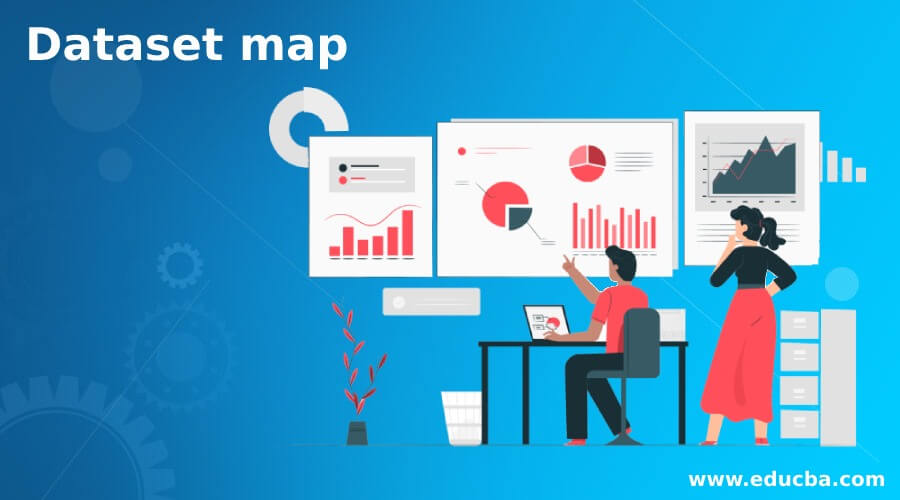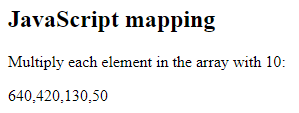Updated March 8, 2023
Introduction to Dataset map
Dataset map is defined as, the interface of the dataset is like object-oriented programming which has encoding feature, it is the concept of serialization and de-serialization and the datasets are the structures in spark SQL which also has encoders to convert the objects and internal binary format, the map() function is the function which is used to map the dataset through one-to-one transformation for example by parameter transformation a function can map dataset elements to a transformed element of the dataset, the map() function takes the name as a first argument, element as a second argument, and return type as a third argument.
What is dataset map?
The map is the function that can be used to map the dataset through one-to-one transformation, and the transformation depends on the parameters it means that the mapping of the functions is going to be done by the transformation of elements, the map() function also allows us to process and transform all the elements in an iteration without using a loop so we can say that the map is can be used instead of loop and by using it the sequence of data can be transformed by using map() function, in which it also depends on the functions which have been provided to it.
Why use a dataset map?
The dataset is used to map top-level containers and it is also used to control and organize the tables and views because the tables and views belong to the dataset so before loading the data in Big Query it creates at least one dataset before it, by using simple SQL statements dataset can communicate with the database we can say that dataset is the communicator to communicate with the database.
So dataset is the collection of domain-specific objects which is very strong and it can be used to transform the elements by using functions or any type of relational operations, every dataset has an un-typed view which is called a data frame also it is a row of a dataset, the operations which are available on datasets is can be divided into actions and the transformations, in which transformation is the operation which gives a new dataset and action is the one type of trigger in which by computation we get a result, where the dataset is little lazy in computations because they only compute the action which can be triggered only when action is done so that to transform the element from one type to another type we need to map the dataset.
Dataset structure
We can pass a function to map, when it should be a map() then it takes a single value from the series and it will return the transformed version of that transformed value, the map() function a new series of values in which all the values have been transformed by using function.
The syntax of transforming map is, map() transform, in which it returns the data value from a dataset.
The dataset consists of series of records or data which can be written in df standard, in which record is a series of bytes which helps to read and write data together and the record concept is useful only when there is a representation of binary data also it contains the set of record which are uniform and that is organized into functional groups, the design of it does not contain the non-sequential data it can be prevented by using the dataset.
The structure of the dataset is specified as,
<Dataset>:: = <Test> <object> {<object>}
<object>:: = <OBJDESC> <AUDIT> [<INFOSPEC>]
{<COMMENT>} <DIMSPEC0> <DIMSPEC1> <DIMSPEC2>
[<DIMSPEC3> ] <DESCRIP0> <Dimgroup1>
{<Dimgroup1> } <Dimgroup2> {<Dimgroup2> }
[ <Dimgroup3> { <Dimgroup3> } ]
{<BADVAL> } { <Procgroup> } { <Auxgroup> }
<Regdata> | <Packdata> | <Compdata>
<Dimgroup1>:: = < DESCRIP1> <DESCVAL> [ <DESCSUP> ]
{<Descgroup>}
<Dimgroup2>:: = <DESCRIP2> <DESCVAL> [ <DESCSUP> ]
{<Descgroup> }
<Dimgroup3> ::= <DESCRIP3> <DESCVAL> [ <DESCSUP> ]
{ <Descgroup> }
<Descgroup> ::= <DESCRIP> <DESCVAL> [ <DESCSUP> ]
<Procgroup> ::= <PROCSPEC> [ <PROCFORM> <PROCVAL> ]
{<PROCDUP> }
<Auxgroup> ::= <AUXSPEC> <AUXRANGE> <AUXVAL> [ <AUXSUP> ]
<Regdata> ::= <REGDAT> { <REGDAT> }
<Packdata> ::= <Packgroup> { <Packgroup> } <PAKDAT>
{<PAKDAT>}
<Compdata> ::= <Compgroup> <COMPDAT> { <COMPDAT> }
<Packgroup> ::= <PAKSPEC> [ <PAKFORM> <PAKVAL> ]
<Compgroup> ::= <COMPSPEC> <COMPLEN>
[<COMPFORM> <COMPVAL> ]
Above is the structure of the dataset.
Example #1:
<!DOCTYPE html>
<html>
<body>
<h2>JavaScript mapping</h2>
<p>Multiply each element in the array with 10:</p>
<p id="demo"></p>
<script>
const numbers = [64, 42, 13, 5];
const newArr = numbers.map(myFunction);
document.getElementById("demo").innerHTML = newArr;
function myFunction(num) {
return num * 10;
}
</script>
</body>
</html>
Output:
Above example, we have written in JavaScript and we try to map every element by multiplying with each element in the given list, and for that, we have created a script which has a list of numbers and take a function and passed the num as a parameter and the output is as shown above.
Example #2:
<!DOCTYPE html>
<html>
<body>
<h2>Mapping of function by using array</h2>
<p>Display a new array with the name of each person in the old array:</p>
<p id="demo"></p>
<script>
const persons = [
{firstname : "Malvika", lastname: "Ronoldo"},
{firstname : "Kaylee", lastname: "Fricy"},
{firstname : "Jaine", lastname: "Cobble"}
];
document.getElementById("demo").innerHTML = persons.map(getFullName);
function getFullName(item) {
return [item.firstname,item.lastname].join(" ");
}
</script>
</body>
</html>
Output:
In this example, we have written a JavaScript code for mapping the functions by using an array for that we have take array of the list and by using the function we try to pass the item of the list and then by joining it we get another list as shown in the above screenshot of the output.
Conclusion
In this article we have explained the concept of dataset map, the map is the function which is used to map the dataset and also we have seen the reason for using it and we have explained the examples, this article will also conclude that the map() function is used in one-to-one transformation.
Recommended Articles
This is a guide to the Dataset map. Here we discuss the concept of dataset map, the map is the function that is used to map the dataset. You may also have a look at the following articles to learn more –





